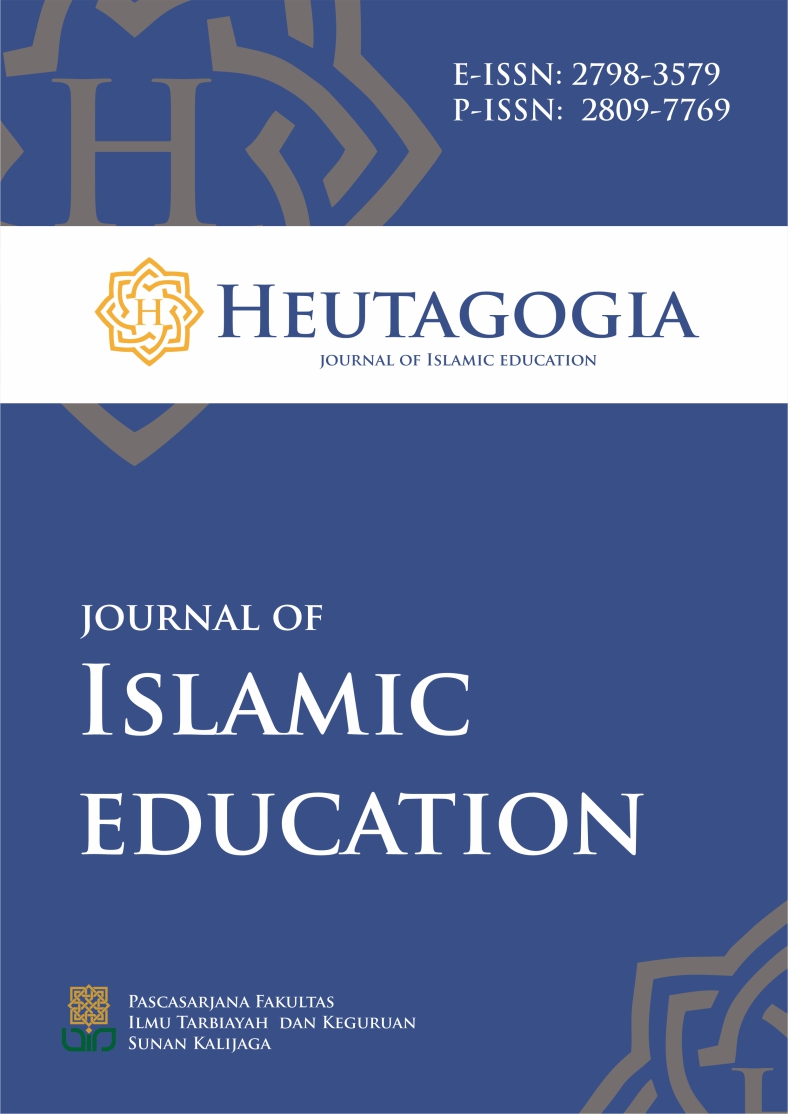The Effectiveness of Spiderweb Learning Media in Enhancing Hijaiyah Letter Recognition Among Early Childhood Learners
DOI:
https://doi.org/10.14421/hjie.2024.42-03Keywords:
Hijaiyah-Letter Recognition, Spiderweb Learning-Media, Early-Childhood EducationAbstract
This study investigates the effectiveness of Spiderweb Learning media in improving the ability of early childhood learners to recognize and read Hijaiyah letters. Employing a quasi-experimental design with a non-equivalent control group, this research involved 40 students from Class B at Kindergarten Pertiwi 26-13 Bogares Kidul, who were selected through purposive sampling. The sample was divided into two groups: an experimental group receiving instruction through web Spiderweb Learning media and a control group taught using conventional methods. The research procedure included pre-tests, instructional interventions, and post-tests to assess learning outcomes. Data collection was conducted through direct observation, interviews, and standardized testing, with analysis performed using SPSS version 28. The Mann-Whitney U test results indicated a statistically significant improvement in the experimental group’s performance compared to the control group, confirming the effectiveness of Spiderweb Learning media as an instructional tool. The findings suggest that interactive learning media can enhance early literacy development by providing engaging and structured stimuli. However, limitations such as the short duration of the intervention and the absence of qualitative engagement measures necessitate further research. Future studies should incorporate longitudinal methodologies and mixed-method approaches to evaluate the long-term impact and broader applicability of web-based learning tools in Arabic literacy education. The study contributes to the growing body of research on digital learning interventions and provides valuable insights for educators and policymakers seeking to enhance early childhood Arabic literacy instruction.
Downloads
References
Ahmad, Pir Noman, Liu Yuanchao, Khursheed Aurangzeb, Muhammad Shahid Anwar, dan Qazi Mazhar ul Haq. “Semantic web-based propaganda text detection from social media using meta-learning.” Service Oriented Computing and Applications, 2024. doi:10.1007/s11761-024-00422-x.
Akhter, Parven. “A young child’s intergenerational practices through the use of visual screen-based multimodal communication to acquire Qur’anic literacy.” Language and Education 30, no. 6 (1 November 2016): 500–518. doi:10.1080/09500782.2016.1141935.
Ali, Tazeen M. “Qur’anic Literacy as Women’s Empowerment: Cultivating Interpretive Authority at the Women’s Mosque of America.” Journal of the American Academy of Religion 89, no. 4 (1 Desember 2021): 1434–61. doi:10.1093/jaarel/lfab098.
Atabik, Nurfuadi, Imam Hidayat, Masruri, dan Sofia Nur. “Digitalization of Educational Quality Management in Higher Education.” Revista de Gestão Social e Ambiental 18, no. 7 SE- (12 Juni 2024): e06776. doi:10.24857/rgsa.v18n7-133.
Chaimaha, Napalai, Supawadee Putthinoi, Suchitporn Lersilp, Jitapa Chawawisuttikool, Saitip Kummuang, Hsiu-Yun Hsu, dan Sasithorn Sung-U. “Development of Web-Based Learning Media on Behavior Management to Enhance Activities of Daily Living for Children with Autism Spectrum Disorder.” Occupational Therapy In Health Care, 2024, 1–18. doi:10.1080/07380577.2024.2415974.
Chakaveh, Sepideh, Detlef Skaley, Patricia Laine, Ralf Haeger, dan Soha Maad. “M3D (Media 3D): a new programming language for web-based virtual reality in e-learning and edutainment.” In Proc. SPIE, 5018:228–35, 2003. doi:10.1117/12.476185.
Diallo, Ibrahima. “Qur’anic and Ajami literacies in pre-colonial West Africa.” Current Issues in Language Planning 13, no. 2 (1 Mei 2012): 91–104. doi:10.1080/14664208.2012.687498.
Edan, Naktal, dan Sanabil A. Mahmood. “Multi-user media streaming service for e-learning based web real-time communication technology.” IJECE: International Journal of Electrical and Computer Engineering 11, no. 1 (2021): 567–74. doi:10.11591/ijece.v11i1.pp567-574.
Elshareif, M E E, N A Ahmad Alias, N Jomhari, dan H Sofian. “Smart Glove with Mobile Application to Detect Static Arabic Hijaiyah Hand Code for Quran Recitation.” In 2024 21st Learning and Technology Conference (L&T), 64–69, 2024. doi:10.1109/LT60077.2024.10469054.
Falloon, Garry. “From digital literacy to digital competence: the teacher digital competency (TDC) framework.” Educational Technology Research and Development 68, no. 5 (2020): 2449–72. doi:10.1007/s11423-020-09767-4.
Hania, Irfan, Muhammad Sya’dullah Fauzi, Suteja Suteja, Era Sastra Pangestu, Faiqotussana Faiqotussana, dan Moh. Faza Rosyada. “The Phonics Method in Aṣwat Learning and Its Influence on the Reading Ability of Ibtidaiyyah Madrasah Students.” al Mahāra: Jurnal Pendidikan Bahasa Arab 8, no. 2 (2022): 231–47. doi:10.14421/almahara.
Li, Tingyu, Jing Yu, dan Haiping Zhang. “Web of things based social media fake news classification with feature extraction using pre-trained convoluted recurrent network with deep fuzzy learning.” Theoretical Computer Science 931 (2022): 65–77. doi:10.1016/j.tcs.2022.07.031.
Muhammad, A F, D Ekky Pratama, dan A Alimudin. “Development Of Web Based Application With Speech Recognition As English Learning Conversation Training Media.” In 2019 International Electronics Symposium (IES), 571–76, 2019. doi:10.1109/ELECSYM.2019.8901594.
Nasir, M, Hasyimi, Mahdi, dan Amru. “Modeling System Test of English as a Foreign Language as a Web-Based Learning Media.” IOP Conference Series: Materials Science and Engineering 536, no. 1 (2019): 12130. doi:10.1088/1757-899X/536/1/012130.
Pramuniati, I. “Development of web-based French language learning media on Réception Écrite courses.” Zenodo 17 Agustus (2020). doi:10.5281/zenodo.3987679.
Risnasari, Medika, Laili Cahyani, dan Abd Asis. “Web-based herbal plant dictionary for generation Z student’s learning media.” In AIP Conference Proceedings, 2867:30018, 2024. doi:10.1063/5.0227737.
Singla, Annie, dan Rajat Agrawal. “DisDSS: a novel Web-based smart disaster management system for determining the nature of a social media message for decision-making using deep learning – case study of COVID-19.” Global Knowledge, Memory and Communication 73, no. 8/9 (1 Januari 2024): 1044–65. doi:10.1108/GKMC-07-2022-0180.
Zhang, Chengde, Kai Mei, dan Xia Xiao. “Cross-media web video topic detection based on heterogeneous interactive tensor learning.” Knowledge-Based Systems 283 (2024): 111153. doi:10.1016/j.knosys.2023.111153.
Downloads
Published
How to Cite
Issue
Section
License

This work is licensed under a Creative Commons Attribution-NonCommercial 4.0 International License.















